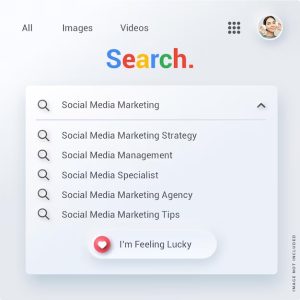Search engine optimization (SEO) is the process of improving your website’s visibility and relevance in organic search results. SEO can help you attract more traffic, leads, and customers from search engines like Google and Bing. But how can you do SEO on your own without hiring an agency or a consultant?
In this blog post, I will show you the basic steps of SEO that you can follow to optimize your website and grow your online presence.
Step 1: Do Keyword Research

Keyword research is the process of finding out what words and phrases your target audience uses when they search for your products, services, or topics. Keyword research helps you understand the demand, competition, and intent of your potential customers. It also helps you create content that matches their needs and expectations.
To do keyword research, you can use various tools like Google Keyword Planner or Ahrefs Keywords Explorer. These tools can help you generate keyword ideas, analyze their metrics, and find related keywords. You can also use Google Search Console2 or Bing Webmaster Tools to see what keywords your website already ranks for and how much traffic it brings.
The goal of keyword research is to find the best keywords for your website that have high search volume, low competition, and high relevance. You should also consider the search intent of the keywords, which is the goal or purpose behind the search query.
For example, some keywords have informational intent (e.g., “how to do SEO”), while others have transactional intent (e.g., “buy SEO tools”). You should align your content with the search intent of your target keywords.
Step 2: Create Content
SEO content is content that is designed to rank well in search engines and satisfy the search intent of your target audience. SEO content can be in various formats, such as blog posts, articles, guides, videos, infographics, podcasts, etc. The key to creating SEO content is to provide value, quality, and relevance to your readers.
To create SEO content, you should follow these best practices:
- Use your target keyword in the title, URL, meta description, and first paragraph of your content. This helps search engines understand what your content is about and rank it accordingly.
- Use headings (h2s and h3s) to structure your content and make it easy to read and scan. Headings also help search engines identify the main topics and subtopics of your content.
- Use related keywords and synonyms throughout your content to enrich it and avoid keyword stuffing. This helps search engines understand the context and meaning of your content better.
- Write short paragraphs, use transition words, and eliminate hard-to-read or redundant words. This helps improve the readability and user experience of your content.
- Add internal links to other relevant pages on your website to keep your readers engaged and reduce the bounce rate. Internal links also help search engines crawl and index your website better.
- Add external links to authoritative and trustworthy sources to support your claims and provide additional value to your readers. External links also help build credibility and trust for your website.
- Optimize your images by using descriptive file names, alt texts, captions, and compression. This helps improve the loading speed, accessibility, and SEO of your images.
- Include a clear call-to-action (CTA) at the end of your content to encourage your readers to take the next step. For example, you can ask them to subscribe to your newsletter, download a free ebook, or contact you for a consultation.
Step 3: Do On-Page SEO

On-page SEO is the process of optimizing the individual pages of your website for search engines and users. On-page SEO involves various elements such as title tags, meta descriptions, URLs, headings, images, content, etc. The goal of on-page SEO is to make your pages as clear, relevant, and user-friendly as possible.
To do on-page SEO, you should follow these best practices:
- Use descriptive and unique title tags for each page of your website. Title tags are the clickable headlines that appear in search results and browser tabs. They should include your target keyword and a compelling value proposition.
- Use concise and persuasive meta descriptions for each page of your website. Meta descriptions are the snippets that appear below the title tags in search results. They should summarize the main benefit or purpose of your page and include a CTA.
- Use short and descriptive URLs for each page of your website. URLs are the web addresses that appear in the browser bar and search results. They should include your target keyword and reflect the hierarchy of your website.
- Use schema markup to add structured data to your pages. Schema markup is a code that helps search engines understand the type and meaning of your content better. It can also help you generate rich snippets in search results, such as ratings, reviews, prices, etc.
- Use a responsive design to make your website mobile-friendly. Responsive design is a technique that adapts your website to different screen sizes and devices. It can help you improve the user experience, loading speed, and SEO of your website.
Step 4: Do Off-Page SEO
Off-page SEO is the process of improving the authority, popularity, and reputation of your website through external factors. Off-page SEO involves various activities such as link building, social media marketing, guest posting, influencer outreach, etc. The goal of off-page SEO is to build trust, credibility, and awareness for your website.
To do off-page SEO, you should follow these best practices:
- Build high-quality backlinks to your website from other relevant and authoritative websites. Backlinks are links that point to your website from other websites. They act as votes of confidence and signals of quality for your website. They can also drive referral traffic and exposure to your website.
- Create and share engaging content on social media platforms such as Facebook, Twitter, Instagram, LinkedIn, etc. Social media can help you connect with your target audience, increase your brand awareness, and generate social signals for your website.
- Write and publish guest posts on other reputable websites in your niche or industry. Guest posting can help you showcase your expertise, build relationships with other influencers, and earn backlinks to your website.
- Reach out to influencers and bloggers in your niche or industry and ask them to mention or review your website, products, or services. Influencer marketing can help you leverage the trust and authority of others to promote your website and increase your traffic.
Step 5: Monitor and Analyze Your Performance

The final step of doing SEO on your own is to monitor and analyze your SEO performance and results. This helps you measure the effectiveness of your SEO efforts, identify the strengths and weaknesses of your website, and find new opportunities for improvement.
To monitor and analyze your SEO performance, you can use various tools such as Google Analytics, Google Search Console, Bing Webmaster Tools, Ahrefs Site Explorer, or Moz Pro.
These tools can help you track various metrics such as organic traffic, rankings, conversions, bounce rate, etc. They can also help you identify and fix any issues or errors that might affect your SEO.
Some of the key questions that you should ask yourself when analyzing your SEO performance are:
- How much organic traffic are you getting from search engines?
- What are the main sources and channels of your organic traffic?
- What are the most popular pages and keywords on your website?
- How are you ranking for your target keywords and competitors?
- How are you performing on different devices and locations?
- How are you converting your organic traffic into leads or customers?
- What are the main challenges or problems that you are facing with SEO?
- What are the main opportunities or areas that you can improve with SEO?
Based on the answers to these questions, you can adjust your SEO strategy accordingly and optimize your website for better results.
How to do SEO on Your Own (Easy Steps)
SEO is not a one-time thing but an ongoing process that requires constant learning, testing, and improvement. Doing SEO on your own can be challenging but rewarding if you follow the basic steps outlined in this guide.
By doing keyword research, creating SEO content, doing on-page and off-page SEO, and monitoring and analyzing your SEO performance, you can optimize your website for search engines and users and grow your online presence.





